Having handled an original halberd from the early 1500s i believe it was..... you definitely have a sense of "you'd be an idiot to mess with someone holding this" short of course, of being in armor, and with friends similarly armored.
Glaives and halberds are some of my favorite weapon classes because of that, they're an all-around useful tool for combat. Stick, hack, jab or smash, they do it all.
| Ken Speed wrote: |
| Sa'ar
While I didn't have that particular item in mind, it is much closer to my mental image of a glaive. Its scary when you think of the force someone could generate with something like that. Thanks , Ken Speed |
Ken, what I've captured in the pic isn't the typical glaive, nor European at all. It is a unique weapon, an executioner's axe from early 19th century Pakistan and also made as a processional piece for one of the rajas. Not very handy in the battle field, weighing whopping over 30 kilos (appr. 70 pounds)! I could remember it because of your nice description of "naginata on steroids", and this item surely fills the bill. But one-of-a-kind, in the Royal Armouries, Leeds.
True glaive or voulge has a thin blade as it should be light enough and fast. The "munition grade" voulges from France are pretty similar in size and shape to some of the Lochaber axes of Scotland, lacking a spear blade and having a back hook on a huge broad blade.
Have you seen Arma Bohemia's vouge francais? It's a very nice entry.
 Attachment: 141.98 KB
Attachment: 141.98 KB
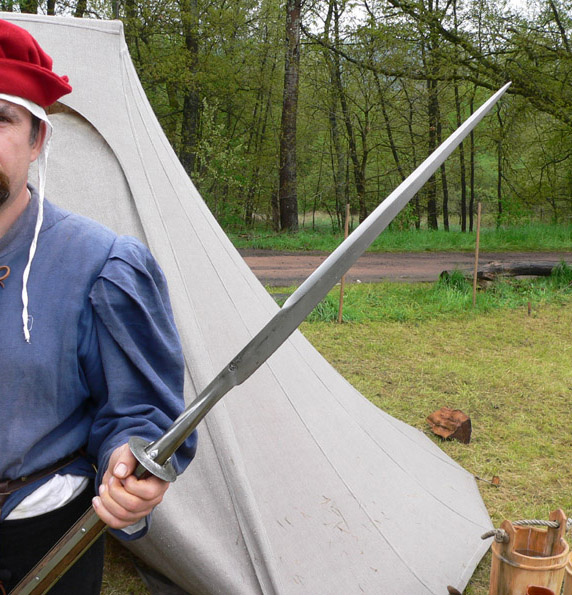
 Attachment: 89.83 KB
Attachment: 89.83 KB
[ Download ]

[ Download ]
The first two shown below may be what you're thinking of, Ken. There are many variants. The last image below is the typical couteau de breche form (also often referred to as a glaive).
 Attachment: 18.5 KB
Attachment: 18.5 KB
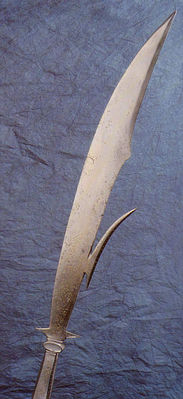
 Attachment: 16.28 KB
Attachment: 16.28 KB
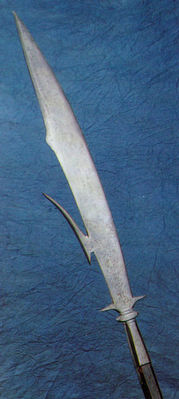
 Attachment: 19.62 KB
Attachment: 19.62 KB
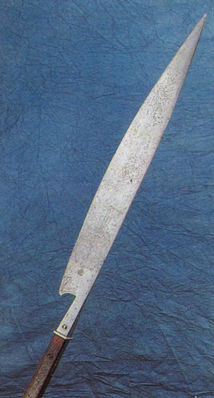



Please excuse my ignorance but are there any defined boundries by experts as in " These pieces fall within the accepted definitions of a glaive" or These pieces on the other hand are much nearer, say partisans than glaives" ?
If that is yourself in the photo holding the Arma Bohemia piece Mr. Flynt it is a beauty.
If that is yourself in the photo holding the Arma Bohemia piece Mr. Flynt it is a beauty.
"Sa'ar wrote, "... an executioner's axe from early 19th century Pakistan and also made as a processional piece for one of the rajas. Not very handy in the battle field, weighing whopping over 30 kilos (appr. 70 pounds)! " Man, thats just nasty! Gives the word "overkill" a whole new meaning ! The executioner would split the chopping block! I need a drink.
Thanks Sa'ar I think I'll be having nightmares :lol:
Ken Speed
Thanks Sa'ar I think I'll be having nightmares :lol:
Ken Speed
Sean,
Yes, the top two in your 4:23 note today are the type I had in mind. They all look like really bad news but there's something about that curving scimitar shaped blade on a long pole that is really chilling. I looked at Wikipedia and it said that Silver said that essentially that these were the most dangerous of weapons.
Ken Speed
Yes, the top two in your 4:23 note today are the type I had in mind. They all look like really bad news but there's something about that curving scimitar shaped blade on a long pole that is really chilling. I looked at Wikipedia and it said that Silver said that essentially that these were the most dangerous of weapons.
Ken Speed
| Ken Speed wrote: |
| Man, thats just nasty! Gives the word "overkill" a whole new meaning ! The executioner would split the chopping block! I need a drink.
Thanks Sa'ar I think I'll be having nightmares :lol: Ken Speed |
Sorry about the nightmares mate... ;)
"Overkill" is an understatement: the haft can hardly be grasped with two hands because of the large diameter, at the bottom, can't be seen in the pic, there is a large spherical pommel almost the size of a handball, probably for counter balance. You don't have to put any effort in the downwards movement, just aim it well and let gravity do the job :evil:
| J. D. Carter wrote: |
| Please excuse my ignorance but are there any defined boundries by experts as in " These pieces fall within the accepted definitions of a glaive" or These pieces on the other hand are much nearer, say partisans than glaives" ?
If that is yourself in the photo holding the Arma Bohemia piece Mr. Flynt it is a beauty. |
It's not me in the photo, unfortunately. I'm a great admirer--from afar--of Arma Bohemia's work.
Categorical/typological boundaries in this field are very, very subtle. The easiest way to separate, say, a couteau de bréche (küse) from a glaive is the socket. A glaive's socket is centered on the blade while a CDB's socket is in line with the back of the blade, like a big kitchen knife (probably the origin of the type, I would guess). See the photos above. Otherwise, there just isn't much difference--both are long, broad, single-edged blades. The vouge francais splits the difference, and usually is so narrow that it could logically be categorized among spears. Certainly, there are spears with broader blades than some vouge francais.
This vagueness is a huge obstacle to the study of polearms. This field of arms study is so orphaned, historically, that folks haven't even agreed what to call it. Polearms? Hafted weapons? Staff weapons? I choose polearms because the other terms are misleading or too inclusive. John Waldman's recent book, Hafted Weapons In Medieval and Renaissance Europe, is the best resource on the subject, in spite of minor flaws. But I'm sure there are folks who would question the boundaries he draws there.
I believe we need an alpha-numerical typology for polearms. That way, when somebody starts talking about "a polearm of type 1a" we'd all know exactly what that looks like and could skip the debate over what constitutes a "spear". I did some work on a basic typology last year for inclusion in an article, but decided that it's too big a project to be essentially a sidebar. I may come back to it in the future and either write formally or introduce the idea for discussion in this forum. I'm not going to produce a complete typology under any circumstances, but I would like to propose something and see how it's received and debated by others interested in the field.
I'll be formally addressing these and other polearms issues, probably this year.
Hi Sa'ar,
You said,"Overkill" is an understatement: the haft can hardly be grasped with two hands because of the large diameter, at the bottom, can't be seen in the pic, there is a large spherical pommel almost the size of a handball, probably for counter balance. You don't have to put any effort in the downwards movement, just aim it well and let gravity do the job "
Here's a theory (theories are worth about the same as opinions by the by ;) ) I think that the big ball was a pivot point! Nobody could reliably swing and control something that had a long shaft with a head that weighed seventy pounds. I think that this is essentially a guillotine (SP?) without a frame. There would be a stage or platform with the block for the executee and the appropriate distance away from the block would be a dished out recess in the floor where the spherical pommel would rest;
then its just aim and release as you mentioned!
Lets talk about weapons and wholesale slaughter and wholesome things this execution stuff is ghoulish! :lol:
Ken Speed
You said,"Overkill" is an understatement: the haft can hardly be grasped with two hands because of the large diameter, at the bottom, can't be seen in the pic, there is a large spherical pommel almost the size of a handball, probably for counter balance. You don't have to put any effort in the downwards movement, just aim it well and let gravity do the job "
Here's a theory (theories are worth about the same as opinions by the by ;) ) I think that the big ball was a pivot point! Nobody could reliably swing and control something that had a long shaft with a head that weighed seventy pounds. I think that this is essentially a guillotine (SP?) without a frame. There would be a stage or platform with the block for the executee and the appropriate distance away from the block would be a dished out recess in the floor where the spherical pommel would rest;
then its just aim and release as you mentioned!
Lets talk about weapons and wholesale slaughter and wholesome things this execution stuff is ghoulish! :lol:
Ken Speed
I've just recently seen a 15th c. German painting showing a short-hafted cleaver. Shown in use, the weapon is actually resting on the victim's neck (block beneath) and is to be struck by a mallet/maul. In essence, it is a wedge used to separate the victim from his head. So, it's at least possible that the weapon you're discussing might be built to be struck rather than swung. Just a thought. I know almost nothing about Asian arms.
| Sean Flynt wrote: |
|
I believe we need an alpha-numerical typology for polearms. That way, when somebody starts talking about "a polearm of type 1a" we'd all know exactly what that looks like and could skip the debate over what constitutes a "spear". I did some work on a basic typology last year for inclusion in an article, but decided that it's too big a project to be essentially a sidebar. I may come back to it in the future and either write formally or introduce the idea for discussion in this forum. I'm not going to produce a complete typology under any circumstances, but I would like to propose something and see how it's received and debated by others interested in the field. I'll be formally addressing these and other polearms issues, probably this year. |
I’m looking forward to it Sean. I’d like to see what you come up with. Personally, I find the lack of agreed upon definitions to describe polearms quite frustrating. I usually resort to using a pen and paper to describe what I’m talking about and people often say “Oh, you mean an Italian bill”, “No, it’s a guisarme”, “I thought that was a fauchard” etc.
Whatever you want to call it, I’m thinking of making one of those things with a long spike and a big hook as shown in the museum photos you posted on the first page of this topic. I’m not sure how great they’d be for cutting but otherwise they seem rather versatile (and they look very cool).
I’d like to read more about polearms. I still consider the sword to be the king of weapons, easily carried, well suited to ornamentation, efficiently lethal and tirelessly elegant but would prefer to begin a battle with it on my hip and a savagely sharp pointy polearm in my hands.
[quote="D. Austin"]
There isn't much out there. Get Waldman's book if you can (it's not going to get cheaper, and probably will more than double in value). George Snook's monograph is certainly worth having. Used to be available new for under $20, but I once saw it offfered at $75, which is ridiculous for this little paperbound booklet. Moreover, you can download the entire thing for free here:
http://www.virtuatheque.free.fr/The Halberd and Other European Polearms.pdf
I don't know if the author has placed this in the public domain or what, so I don't know if this PDF violates copyright restrictions. Assuming Snook is still alive, he's 83. He's some kind of legend in his own field (see below,) and might not need the royalties from his hobby writing. He may have decided to place his work in the public domain, either directly or by default.
Aug. 17, 2007
CHICAGO, Ill. - Dr. George A. Snook, orthopaedic consultant and team physician for UMass athletics for 32 years, has been inducted into the American Orthopaedic Society for Sports Medicine (AOSSM) Hall of Fame at the AOSSM annual meeting in Calgary, Alberta, Canada. This is the Society's highest accolade, reserved for outstanding leaders in sports medicine and service as team physicians.
| Sean Flynt wrote: |
| I’d like to read more about polearms. |
There isn't much out there. Get Waldman's book if you can (it's not going to get cheaper, and probably will more than double in value). George Snook's monograph is certainly worth having. Used to be available new for under $20, but I once saw it offfered at $75, which is ridiculous for this little paperbound booklet. Moreover, you can download the entire thing for free here:
http://www.virtuatheque.free.fr/The Halberd and Other European Polearms.pdf
I don't know if the author has placed this in the public domain or what, so I don't know if this PDF violates copyright restrictions. Assuming Snook is still alive, he's 83. He's some kind of legend in his own field (see below,) and might not need the royalties from his hobby writing. He may have decided to place his work in the public domain, either directly or by default.
Aug. 17, 2007
CHICAGO, Ill. - Dr. George A. Snook, orthopaedic consultant and team physician for UMass athletics for 32 years, has been inducted into the American Orthopaedic Society for Sports Medicine (AOSSM) Hall of Fame at the AOSSM annual meeting in Calgary, Alberta, Canada. This is the Society's highest accolade, reserved for outstanding leaders in sports medicine and service as team physicians.
Snook's monograph is currently available and affordable on ebay. I bought one a year ago for $12 and two more copies most recently, from the same seller. Check here: http://cgi.ebay.com/The-Halberd-1300-1650_W0Q...0221100675
| Sa'ar Nudel wrote: |
| Snook's monograph is currently available and affordable on ebay. I bought one a year ago for $12 and two more copies most recently, from the same seller. Check here: http://cgi.ebay.com/The-Halberd-1300-1650_W0Q...0221100675 |
Thanks Sa'ar. I just bought one. Can't wait for it to arrive.
I tried that link Sean, but it didn't seem to work. For the price I paid, I'm happy to have something that can actually sit on the bookshelf. Thanks again for all your help.
Darren.
Here's the link to Snook's booklet.
http://virtuatheque.free.fr/The%20Halberd%20a...learms.pdf
In the back there are basic silhouettes of polearm types and names for each one plus a glossary of various polearms types.
The following book also has some good drawing / diagrams of polearms, very little information and no photographs, just diagrams.
The New Weapons of the World Encyclopedia: An International Encyclopedia from 5000 B.C. to the 21st Century
by Diagram Group
http://www.amazon.com/New-Weapons-World-Encyc...amp;sr=8-1
Where's the cheapest place to order Waldman's book from?
Thanks
Danny
http://virtuatheque.free.fr/The%20Halberd%20a...learms.pdf
In the back there are basic silhouettes of polearm types and names for each one plus a glossary of various polearms types.
The following book also has some good drawing / diagrams of polearms, very little information and no photographs, just diagrams.
The New Weapons of the World Encyclopedia: An International Encyclopedia from 5000 B.C. to the 21st Century
by Diagram Group
http://www.amazon.com/New-Weapons-World-Encyc...amp;sr=8-1
Where's the cheapest place to order Waldman's book from?
Thanks
Danny
Might throw inn a pic of my not-so-new glaive, as well;
 Attachment: 35.46 KB
Attachment: 35.46 KB
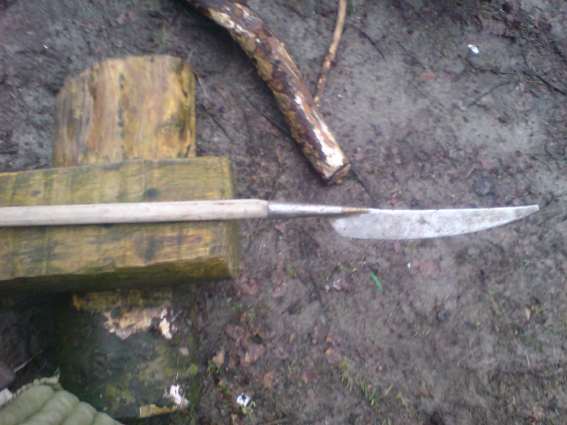

Page 2 of 2
You cannot post new topics in this forumYou cannot reply to topics in this forum
You cannot edit your posts in this forum
You cannot delete your posts in this forum
You cannot vote in polls in this forum
You cannot attach files in this forum
You can download files in this forum
All contents © Copyright 2003-2006 myArmoury.com — All rights reserved
Discussion forums powered by phpBB © The phpBB Group
Switch to the Full-featured Version of the forum
Discussion forums powered by phpBB © The phpBB Group
Switch to the Full-featured Version of the forum